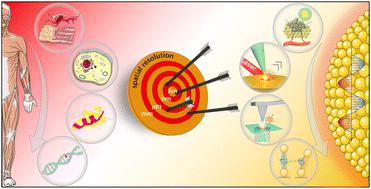当前位置:
X-MOL 学术
›
Chem. Soc. Rev.
›
论文详情
Our official English website, www.x-mol.net, welcomes your
feedback! (Note: you will need to create a separate account there.)
Advanced plasmonic technologies for multi-scale biomedical imaging
Chemical Society Reviews ( IF 40.4 ) Pub Date : 2022-11-15 , DOI: 10.1039/d2cs00525e Jia-Sheng Lin 1 , Xiang-Dong Tian 1 , Gang Li 1 , Fan-Li Zhang 2 , Yan Wang 1 , Jian-Feng Li 1, 2, 3
Chemical Society Reviews ( IF 40.4 ) Pub Date : 2022-11-15 , DOI: 10.1039/d2cs00525e Jia-Sheng Lin 1 , Xiang-Dong Tian 1 , Gang Li 1 , Fan-Li Zhang 2 , Yan Wang 1 , Jian-Feng Li 1, 2, 3
Affiliation

|
The use of imaging technologies has been critical in deciphering biological phenomena, structures, and mechanisms across a wide range of spatial scales. The spatial resolution of traditional imaging modalities cannot meet the needs of high-precision research and diagnosis in biomedical fields. Plasmon resonance is the light–matter interaction that allows localizing far-field radiation in the near field with an intense electromagnetic field, enhancing the nanometric ablation, elastic/inelastic scattering of the adsorbate, and photoluminescence of the fluorophore nearby. Further, plasmon resonance scattering of nanoparticles can sensitively indicate the local environmental changes. This is accomplished by combining the spatially resolved capability with molecular spectrometry techniques such as Raman, infrared, fluorescence, etc., leading to a series of excellent imaging techniques to interrogate diverse biological processes from the tissue to subcellular level. In this tutorial review, we first provide the fundamental aspects of plasmonics. Then we give a systematic discussion of the working principle of these plasmon-based imaging techniques with an emphasis on the achievable spatial resolutions: surface-enhanced Raman spectroscopy (micrometre to nanometre), tip-enhanced ablation and ionization mass spectrometry (submicrometre), scattering-type scanning near-field optical microscopy (nanometre), tip-enhanced Raman spectroscopy (nanometre), tip-enhanced fluorescence spectroscopy (nanometre), and plasmon/molecular ruler microscopy (nanometre to angstrom). We also review the recent developments of the bioimaging applications of these techniques and expect that the plasmon-based techniques will not only pave a new way to decipher mysteries in life sciences but also hold great potential to be extended from fundamental research studies to real-life biomedical applications.
中文翻译:

用于多尺度生物医学成像的先进等离子体技术
成像技术的使用对于破译各种空间尺度的生物现象、结构和机制至关重要。传统成像模态的空间分辨率无法满足生物医学领域高精度研究和诊断的需要。等离激元共振是一种光-物质相互作用,它允许在具有强电磁场的近场中定位远场辐射,增强纳米消融、吸附物的弹性/非弹性散射以及附近荧光团的光致发光。此外,纳米粒子的等离子体共振散射可以灵敏地指示局部环境变化。这是通过将空间分辨能力与分子光谱技术(如拉曼、红外、荧光、等等, 导致一系列优秀的成像技术来审视从组织到亚细胞水平的各种生物过程。在本教程回顾中,我们首先提供等离子体的基本方面。然后我们系统地讨论了这些基于等离子体的成像技术的工作原理,重点是可实现的空间分辨率:表面增强拉曼光谱(微米到纳米)、针尖增强消融和电离质谱(亚微米)、散射型扫描近场光学显微镜(纳米)、尖端增强拉曼光谱(纳米)、尖端增强荧光光谱(纳米)和等离子体/分子标尺显微镜(纳米至埃)。
更新日期:2022-11-15
中文翻译:

用于多尺度生物医学成像的先进等离子体技术
成像技术的使用对于破译各种空间尺度的生物现象、结构和机制至关重要。传统成像模态的空间分辨率无法满足生物医学领域高精度研究和诊断的需要。等离激元共振是一种光-物质相互作用,它允许在具有强电磁场的近场中定位远场辐射,增强纳米消融、吸附物的弹性/非弹性散射以及附近荧光团的光致发光。此外,纳米粒子的等离子体共振散射可以灵敏地指示局部环境变化。这是通过将空间分辨能力与分子光谱技术(如拉曼、红外、荧光、等等, 导致一系列优秀的成像技术来审视从组织到亚细胞水平的各种生物过程。在本教程回顾中,我们首先提供等离子体的基本方面。然后我们系统地讨论了这些基于等离子体的成像技术的工作原理,重点是可实现的空间分辨率:表面增强拉曼光谱(微米到纳米)、针尖增强消融和电离质谱(亚微米)、散射型扫描近场光学显微镜(纳米)、尖端增强拉曼光谱(纳米)、尖端增强荧光光谱(纳米)和等离子体/分子标尺显微镜(纳米至埃)。











































 京公网安备 11010802027423号
京公网安备 11010802027423号